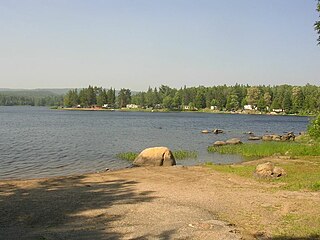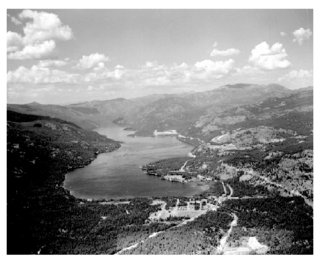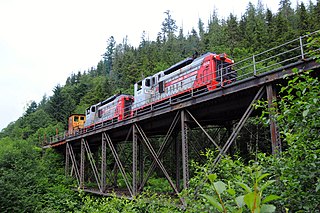
The Snoqualmie River is a 45-mile (72 km) long river in King County and Snohomish County in the U.S. state of Washington. The river's three main tributaries are the North, Middle, and South Forks, which drain the west side of the Cascade Mountains near the town of North Bend and join near the town of Snoqualmie just above the Snoqualmie Falls. After the falls the river flows north through rich farmland and the towns of Fall City, Carnation, and Duvall before meeting the Skykomish River to form the Snohomish River near Monroe. The Snohomish River empties into Puget Sound at Everett. Other tributaries of the Snoqualmie River include the Taylor River and the Pratt River, both of which enter the Middle Fork, the Tolt River, which joins at Carnation, and the Raging River at Fall City.

Willmore Wilderness Park, located in Alberta, Canada, is a 4,600-square-kilometre (1,800 sq mi) wilderness area adjacent to Jasper National Park. It is lesser known and less visited than Jasper National Park. There are no public roads, bridges or buildings. There are, however, several ranger cabins in the park that are available as a courtesy to visitors.

The Mattawa River is a river in central Ontario, Canada. It flows east from Trout Lake east of North Bay and enters the Ottawa River at the town of Mattawa. Counting from the head of Trout Lake, it is 76 km in length. The river's name comes from the Algonquin word for "meeting of waterways".
Highway 28 is an east-west highway on the northern part of Vancouver Island, within the Strathcona Regional District. It is the main link to the northern part of Strathcona Provincial Park and the remote logging communities of Gold River and Tahsis, on the northwest coast of the Island. The highway first opened in 1970. Before the section of Highway 19 from Campbell River to Port Hardy was opened in 1979, Highway 28 acted as the main access to Port Hardy and various other communities on the northern tip of the Island, aided by a system of local logging roads leading from the highway to the various north Island communities.

The Pend Oreille River is a tributary of the Columbia River, approximately 130 miles (209 km) long, in northern Idaho and northeastern Washington in the United States, as well as southeastern British Columbia in Canada. In its passage through British Columbia its name is spelled Pend-d'Oreille River. It drains a scenic area of the Rocky Mountains along the U.S.-Canada border on the east side of the Columbia. The river is sometimes defined as the lower part of the Clark Fork, which rises in western Montana. The river drains an area of 66,800 square kilometres (25,792 sq mi), mostly through the Clark Fork and its tributaries in western Montana and including a portion of the Flathead River in southeastern British Columbia. The full drainage basin of the river and its tributaries accounts for 43% of the entire Columbia River Basin above the confluence with the Columbia. The total area of the Pend Oreille basin is just under 10% of the entire 258,000-square-mile (670,000 km2) Columbia Basin. Box Canyon Dam is currently underway on a multimillion-dollar project for a fish ladder.
Meru is a city in eastern Kenya. It is the headquarters of the Meru County, and the seventh largest urban centre in the country. Meru forms a municipal council with a population of 240,900 residents.

The Deep Fork National Wildlife Refuge (DFNWR) is part of the United States system of National Wildlife Refuges, and is a critical resource for wildfowl that migrate along the Central Flyway in Spring and Fall. It is located in Eastern Oklahoma, near the city of Okmulgee. The preserve runs along both banks of the Deep Fork River for about 20 miles (32 km). According to TravelOK, DFNWR receives about 45,000 visitors every year.

The Salt Lake Stadium, officially the Vivekananda Yuba Bharati Krirangan, is an all-seater multipurpose stadium located in Bidhannagar with a current capacity of about 85,000 spectators. The Salt Lake Stadium is the main home ground of football clubs ATK Mohun Bagan, East Bengal and Mohammedan. It is the second largest stadium in India by seating capacity. Before its renovation in 2011, it was the largest football stadium in the world, having a seating capacity of 120,000. Prior to the construction and opening of Rungrado May Day Stadium in 1989, it was the largest football stadium in the world. The stadium hosted the final match of the 2017 FIFA U-17 World Cup, alongside hosting other matches of the tournament. As part of security measures for the 2017 U-17 World Cup, the stadium was only open for 66,687 viewers. It will be used again for the 2021 FIFA U-17 Women's World Cup.
State Highway 82 is an 85.3-mile-long (137.3 km) state highway in the U.S. state of Colorado. Its western half provides the principal transportation artery of the Roaring Fork Valley on the Colorado Western Slope, beginning at Interstate 70 (I-70) and U.S. Highway 6 in Glenwood Springs southeast past Carbondale, Basalt and Aspen. From there it continues up the valley to cross the Continental Divide at Independence Pass. On the Eastern Slope, it follows Lake Creek past some of Colorado's highest mountains to Twin Lakes Reservoir, where it ends at US 24 south of Leadville.

Cove Lake State Park is a state park in Campbell County, Tennessee, in the southeastern United States. The park consists of 673 acres (2.72 km2) situated around Cove Lake, an impoundment of Cove Creek created by the completion of Caryville Dam in 1936. The park's location is adjacent to the town of Caryville and just west of Jacksboro.

Christina Lake is an unincorporated recreational area in the Boundary Country of the West Kootenay region of British Columbia, Canada. It is located on Crowsnest Highway, 20 kilometres (12 mi) east of Grand Forks and 73 kilometres (45 mi) southwest of Castlegar.
Norrish Creek is a tributary of the Fraser River. It is located in the Douglas Ranges, the southernmost subrange of the Pacific Ranges of the Coast Mountains of British Columbia, Canada to the north of Nicomen Island. Local residents refer to it as "Suicide Creek." It was named after William Henry Norrish a pioneer Scottish Canadian farmer.

Englewood Railway was a logging railroad on northern Vancouver Island, Canada. Headquartered in Woss, British Columbia, the line ran 90 km (56 mi) from Vernon Lake, through Woss, and past Nimpkish Lake Provincial Park to Beaver Cove. It was the last operating logging railroad in North America. After 100 years of use, railway operations ceased on November 7, 2017, following a deadly derailment in April of that year.
Esary Lake is a small lake located east of Port Alberni, British Columbia, Canada. It lies west of Horne Lake.

The Nanaimo River is a river on Vancouver Island, British Columbia, Canada, located near the city of Nanaimo on the island's east coast. Its headwaters are in the Vancouver Island Ranges of central Vancouver Island and its mouth, the Nanaimo River estuary, is at the south end of Nanaimo Harbour in the Strait of Georgia. The estuary is part of the Pacific Estuary Conservation Program.
Little Blue Lake is a water-filled doline in the Australian state of South Australia located in the state's south-east in the locality of Mount Schank about 20 kilometres (12 mi) south of the municipal seat of Mount Gambier. It is notable locally as a swimming hole and nationally as a cave diving site. It is managed by the District Council of Grant and has been developed as a recreational and tourism venue.










